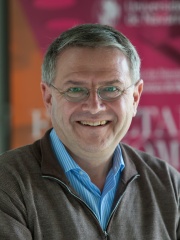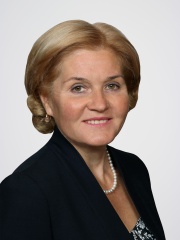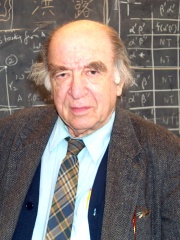
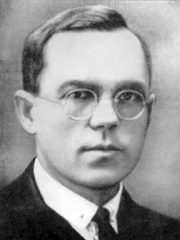
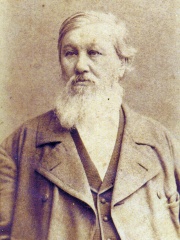
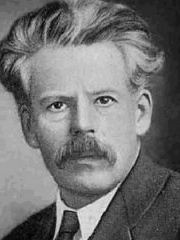


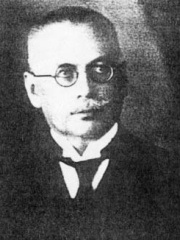
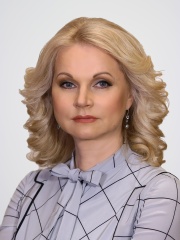
The Most Famous
ECONOMISTS from Russia
This page contains a list of the greatest Russian Economists. The pantheon dataset contains 414 Economists, 12 of which were born in Russia. This makes Russia the birth place of the 6th most number of Economists behind France, and Italy.
Top 10
The following people are considered by Pantheon to be the top 10 most legendary Russian Economists of all time. This list of famous Russian Economists is sorted by HPI (Historical Popularity Index), a metric that aggregates information on a biography's online popularity. Visit the rankings page to view the entire list of Russian Economists.

1. Leonid Hurwicz (1917 - 2008)
With an HPI of 71.38, Leonid Hurwicz is the most famous Russian Economist. His biography has been translated into 57 different languages on wikipedia.
Leonid Hurwicz (Polish pronunciation: [lɛˈɔɲit ˈxurvitʂ]; August 21, 1917 – June 24, 2008) was a Polish–American economist and mathematician, known for his work in game theory and mechanism design. He originated the concept of incentive compatibility, and showed how desired outcomes can be achieved by using incentive compatible mechanism design. Hurwicz shared the 2007 Nobel Memorial Prize in Economic Sciences (with Eric Maskin and Roger Myerson) for his seminal work on mechanism design. Hurwicz was one of the oldest Nobel Laureates, having received the prize at the age of 90. Hurwicz was educated and grew up in Poland, and became a refugee in the United States after Hitler invaded Poland in 1939. In 1941, Hurwicz worked as a research assistant for Paul Samuelson at the Massachusetts Institute of Technology and Oskar Lange at the University of Chicago. He was a research associate for the Cowles Commission between 1942 and 1946. In 1946 he became an associate professor of economics at Iowa State College. Hurwicz joined the University of Minnesota in 1951, becoming Regents' Professor of Economics in 1969, and Curtis L. Carlson Professor of Economics in 1989. He was Regents' Professor of Economics (Emeritus) at the University of Minnesota when he died in 2008. Hurwicz was among the first economists to recognize the value of game theory and was a pioneer in its application. Interactions of individuals and institutions, markets and trade are analyzed and understood today using the models Hurwicz developed.

2. Nikolai Kondratiev (1892 - 1938)
With an HPI of 68.18, Nikolai Kondratiev is the 2nd most famous Russian Economist. His biography has been translated into 33 different languages.
Nikolai Dmitriyevich Kondratiev (; also Kondratieff; Russian: Никола́й Дми́триевич Кондра́тьев; 4 March 1892 – 17 September 1938) was a Russian Soviet economist and proponent of the New Economic Policy (NEP) best known for the business cycle theory known as Kondratiev waves. Despite being a Soviet citizen, he was not a Marxian economist. Kondratiev became an early leading figure of Soviet economics and promoted the NEP's system of small private free market enterprises in the Soviet Union. Kondratiev's theory that Western capitalist economies have long term (50-to-60-year) cycles of boom followed by depression gained recognition inside and outside the Soviet Union. Kondratiev was condemned and imprisoned in 1930, but continued to work until his execution during the Great Purge in 1938. Some of his work was published, for the first time, posthumously.

3. Nikolay Danilevsky (1822 - 1885)
With an HPI of 62.25, Nikolay Danilevsky is the 3rd most famous Russian Economist. His biography has been translated into 28 different languages.
Nikolay Yakovlevich Danilevsky (Russian: Николай Яковлевич Данилевский; 10 December [O.S. 28 November] 1822 – 19 November [O.S. 7 November] 1885) was a Russian naturalist, economist, ethnologist, philosopher, historian and ideologue of pan-Slavism and the Slavophile movement. He expounded a circular view of world history. He is remembered also for his opposition to Charles Darwin's theory of evolution and for his theory of historical-cultural types.

4. Eugen Slutsky (1880 - 1948)
With an HPI of 58.18, Eugen Slutsky is the 4th most famous Russian Economist. His biography has been translated into 18 different languages.
Evgeny "Eugen" Evgenievich Slutsky (Russian: Евге́ний Евге́ньевич Слу́цкий; 7 April [O.S. 19 April] 1880 – 10 March 1948) was a Russian and Soviet mathematical statistician, economist and political economist. He is primarily known for the Slutsky equation and the Slutsky–Yule effect.
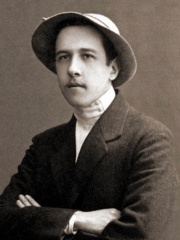
5. Alexander Chayanov (1888 - 1937)
With an HPI of 57.56, Alexander Chayanov is the 5th most famous Russian Economist. His biography has been translated into 17 different languages.
Alexander Vasilyevich Chayanov (Russian: Александр Васильевич Чаянов; 17 January 1888 – 3 October 1937) was a Russian, then Soviet agrarian economist, scholar of rural sociology, and advocate of agrarianism and cooperatives.

6. Leonid Abalkin (1930 - 2011)
With an HPI of 56.98, Leonid Abalkin is the 6th most famous Russian Economist. His biography has been translated into 22 different languages.
Leonid Ivanovich Abalkin (Russian: Леони́д Ива́нович Аба́лкин ; 5 May 1930 – 2 May 2011) was a Russian economist.

7. Petr Aven (b. 1955)
With an HPI of 56.51, Petr Aven is the 7th most famous Russian Economist. His biography has been translated into 24 different languages.
Petr Olegovich Aven (also transliterated Pyotr Aven; Russian: Пëтр Олегович Авен; Latvian: Pjotrs Avens; born 16 March 1955) is a Russian oligarch, economist and politician who also holds Latvian citizenship. Until March 2022 he headed Alfa-Bank, Russia's largest commercial bank. In March 2022, he resigned from the board of directors at Alfa-Bank and LetterOne Group amidst threat of sanctions. In 2023 he was named the 659th richest person in the world, with a net worth of around $4.2 billion. Aven is a member of Russian leader Vladimir Putin's inner circle. Aven has met with Putin regularly, including soon after the Russian invasion in Ukraine. He is one of many Russian oligarchs named in the Countering America's Adversaries Through Sanctions Act, CAATSA. In 2022, Aven was included in EU sanctions imposed in the wake of the Russian invasion of Ukraine. He criticized the sanctions, alleging that they had been applied on a "spurious and unfounded basis," and filed a lawsuit in the European Court of Justice.

8. Ladislaus Bortkiewicz (1868 - 1931)
With an HPI of 56.28, Ladislaus Bortkiewicz is the 8th most famous Russian Economist. His biography has been translated into 20 different languages.
Ladislaus Josephovich Bortkiewicz (Russian Владислав Иосифович Борткевич, German Ladislaus von Bortkiewicz or Ladislaus von Bortkewitsch) (7 August 1868 – 15 July 1931) was a Russian economist and statistician of Polish ancestry. He wrote a book showing how the Poisson distribution, a discrete probability distribution, can be useful in applied statistics, and he made contributions to mathematical economics. He lived most of his professional life in Germany, where he taught at Strassburg University (Privatdozent, 1895–1897) and Berlin University (1901–1931).

9. Tatyana Golikova (b. 1966)
With an HPI of 53.48, Tatyana Golikova is the 9th most famous Russian Economist. Her biography has been translated into 27 different languages.
Tatiana Alexeyevna Golikova (Russian: Татьяна Алексеевна Голикова; born 9 February 1966) is a Russian politician and economist who serves as the Deputy Prime Minister of Russia for Social Policy, Labour, Health Care, and Pension Provision since 2018. From 2007 to 2012, she served as the Minister of Health and Social Development and Chairwoman of the Account Chamber of Russia from 2013 to 2018. She has the federal state civilian service rank of 1st class Active State Councillor of the Russian Federation.
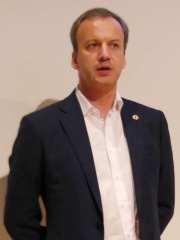
10. Arkady Dvorkovich (b. 1972)
With an HPI of 52.28, Arkady Dvorkovich is the 10th most famous Russian Economist. His biography has been translated into 27 different languages.
Arkady Vladimirovich Dvorkovich (Russian: Арка́дий Влади́мирович Дворко́вич; born 26 March 1972) is a Russian politician and economist, currently serving as the president of the International Chess Federation, FIDE. He was Deputy Prime Minister in Dmitry Medvedev's Cabinet from 21 May 2012 until 7 May 2018. He was previously an Assistant to the President of the Russian Federation from May 2008 to May 2012. He has the federal state civilian service rank of 1st class Active State Councillor of the Russian Federation. Dvorkovich was considered to be a close confidant of Dmitry Medvedev and an important figure in Russian politics. He rose to prominence during Medvedev's presidency but has suffered from the resurgence of Igor Sechin. From 2018 to 2022 he was the Chairman of Skolkovo Foundation. Since 2015, he is also the Chairman of the Board of the Directors in Russian Railways company. Dvorkovich's father, Vladimir Dvorkovich, was an international chess arbiter. Dvorkovich is an official of the Russian Chess Federation and was first elected president of FIDE in October 2018, succeeding Kirsan Ilyumzhinov. He was re-elected for a second term in the elections held on the sidelines of the 44th Chess Olympiad held in Mamallapuram, India, on August 7, 2022.
People
Pantheon has 12 people classified as Russian economists born between 1822 and 1972. Of these 12, 5 (41.67%) of them are still alive today. The most famous living Russian economists include Petr Aven, Tatyana Golikova, and Arkady Dvorkovich. The most famous deceased Russian economists include Leonid Hurwicz, Nikolai Kondratiev, and Nikolay Danilevsky.
Living Russian Economists
Go to all RankingsPetr Aven
1955 - Present
HPI: 56.51
Tatyana Golikova
1966 - Present
HPI: 53.48
Arkady Dvorkovich
1972 - Present
HPI: 52.28
Andrei Shleifer
1961 - Present
HPI: 47.93
Olga Golodets
1962 - Present
HPI: 44.63
Deceased Russian Economists
Go to all RankingsLeonid Hurwicz
1917 - 2008
HPI: 71.38
Nikolai Kondratiev
1892 - 1938
HPI: 68.18
Nikolay Danilevsky
1822 - 1885
HPI: 62.25
Eugen Slutsky
1880 - 1948
HPI: 58.18
Alexander Chayanov
1888 - 1937
HPI: 57.56
Leonid Abalkin
1930 - 2011
HPI: 56.98
Ladislaus Bortkiewicz
1868 - 1931
HPI: 56.28
Overlapping Lives
Which Economists were alive at the same time? This visualization shows the lifespans of the 7 most globally memorable Economists since 1700.

